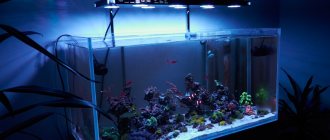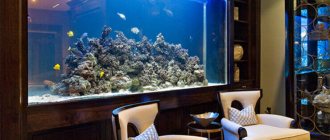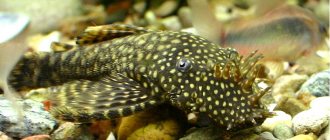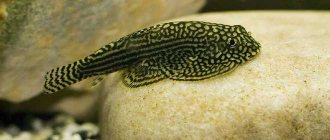ZelAqua is a Russian company that occupies a leading position in the manufacture of terrariums and aquariums. The quality of its products meets all certificates and standards. The manual assembly process of ZelAqua aquariums allows us to achieve outstanding product characteristics. Our own equipment for preparing glass and other components guarantees high quality and control over the process at all stages of assembly.
ZelAqua is a Russian company that occupies a leading position in the manufacture of terrariums and aquariums
According to water composition
According to the characteristics of the water and habitat, aquariums can be marine, freshwater, pseudo-marine or brackish water. The set of necessary tools for such aquariums includes various devices that ensure the maintenance of the required water parameters and the correct microclimate.
- Freshwater aquariums are widely used and contain freshwater types of fish and plants. Maintenance of these aquariums is much easier than that of marine aquariums. They can be of various shapes and sizes and fit perfectly into the interior.
- Marine - intended for the habitat of plants and fish accustomed to salt water conditions. Aquariums are large in size, since marine fish are large in size. They are quite difficult to maintain and require the necessary skills to create the correct chemical composition of water.
- Brackish water is an intermediate type of aquarium that serves as a habitat for fish and plants in desalinated zones of estuaries and bays that can live in brackish waters. These subtropical inhabitants have managed to adapt well to changes in temperature, and can live in both cold and warm water.
Trading options
Aquariums of the trade line are intended for the sale of live fish and crayfish . The forms of the structures are maximally simplified and devoid of decorative elements. They also have a hole for draining water. Glass for commercial products has a thickness of 8-10 mm. The products use the same materials and components as other ZelAqua models.
High quality and reasonable price are a good opportunity to start your own business selling aquatic life. Transparent glass allows buyers to examine animals in small details, evaluate their characteristics and sizes.
Aquarium models are available from 290 to 500 liters in volume
Models are available from 290 to 500 liters. Dimensions are 120x40x60 cm, wall thickness is 8 mm. The cost of aquariums varies from 9 to 14 thousand rubles.
Having decided on the location of the aquarium and the purpose of its purchase, you can choose the appropriate option from the ZelAqua product catalog. Their cost depends on the configuration of the models. You can purchase both a budget tabletop option and an expensive product with a panoramic view for a large room.
By type of design
If we consider the classification of aquariums by design and manufacturing technology, then there are frameless, framed and seamless types.
- Frameless - limited in size, made of organic glass. They are highly reliable and extremely transparent. They are lighter weight and do not require a massive stand. Eliminates exposure to harmful impurities and metals.
- Frame - the structure is made of a special metal frame; they can be of any size. The condition for such aquariums is the constant presence of water in them, otherwise they may become unusable.
- Seamless - most often these round-shaped aquariums are made of glass, acrylic, plexiglass and plexiglass. May have a curved shape. Used for keeping goldfish. The positive qualities of such aquariums include non-leakage, high transparency and thermal insulation of water.
- Asbestos-cement - they contain asbestos fiber, cement and water. Can be built into cabinets, plastered or tiled.
Small-sized products
Aquariums with a small capacity (15-60 l) can be installed on a table or shelf . The products are made of polished silicate glass 1 mm thick. The underlay protects the integrity of the base of the structure and distributes the load.
An affordable price is ensured by reducing the cost of self-made products. All components are made from high quality materials. Models can have a simple design or designer decoration.
Product Lanta 15 is a rectangular aquarium with dimensions of 35x20x40 cm. It can be purchased for 1,300 rubles.
Lanta 40 with dimensions 50x25x40 cm is sold for 2,700 rubles, designed for 40 liters of water. The choice of colors is similar to other aquarium models.
By location
Based on their location, aquariums are also divided into floor-mounted, wall-mounted, screens, and diaramas. The design of such aquariums is designed for the size and shape of certain rooms or houses. These types are used for interior decoration.
- A picture aquarium is a type of wall-mounted aquarium that is framed to create a picture-like effect. Requires proper placement and thoughtful care.
- Built-in - planned at the construction stage of the premises and used in both private and public institutions. They can be built into a wall, arch, furniture and serve as a specific screen partition for zoning a room.
By area of application
Based on their application, aquariums are divided into decorative and special types.
Decorative aquariums serve as a design solution in the interior of a home, where the design and population of the aquarium are carefully thought out, and good gas exchange is calculated. These species are suitable for keeping adult fish. These include:
- general or standard - suitable for beginners due to its versatility. It can contain different species of fish and plants from different geographical zones;
- collection - consists of representatives of fish of the same family. Designed for aquarium specialists who monitor the development and growth of the population of a certain species of fish;
- geographical - the type of such aquariums recreates the geography of the aquatic world, supporting the ethnic style of home interior design in the overall concept. For maximum realism, wallpaper is used on the back wall of the aquarium and decoration with various kinds of decorations;
- open decorated - a specialized design of an aquarium without a lid or cover glass, composed of a kind of collage of plants, a fountain and the aquarium itself. Plants can grow and bloom above water;
- species - contains one or more related species of fish, suitable for observing the behavior and relationships of fish;
- biotope - the difference between such aquariums is achieved by the fact that they reproduce a copy of a certain area of the natural environment in the smallest detail. This freshwater aquarium is usually stocked with tropical fish;
- Dutch - implies the primacy of vegetation in an aquarium, where the presence of fish is not necessary. This aquarium has an elongated shape and imitates an underwater landscape design;
- Paludarium is a kind of water greenhouse that combines underwater and above-water plants. Characterized by high humidity;
- aquaterrarium - serves for keeping both aquarium and terrarium animals leading a semi-aquatic life;
- nano-aquarium - a modern miniature tank mainly with ornamental plants and fish;
- Japanese "Amano" - an aquarium in a minimalist style, conveying decorative elements of the wild Amazon and accurately reproducing the ecosystem of this area;
- mixed - a subspecies of an amateur aquarium containing several species of plants, fish and decorative items, combined according to the conditions of detention.
Special aquariums are designed for specific life support tasks for eggs and growing juveniles. Usually small rectangular in shape, where the water level is up to 35 cm. In turn, they are divided into:
- spawning - used for breeding fish. The size of the spawning tank and all the necessary conditions of detention are selected individually depending on the species of fish. Sterility is important in such an aquarium. The size of spawning aquariums should be smaller than the main one for ease of catching eggs or removing dead eggs;
- incubators - necessary for the support and development of eggs and fish larvae. The main conditions for these aquariums are optimal temperature and oxygen conditions, correct hydrochemical composition and purity of water;
- quarantine and treatment isolators or jigging facilities - intended for the treatment or adaptation of new inhabitants. Parameters and design depend on the size of the fish. Conditions include hygiene, space and water quality control;
- nursery - these containers look like a trough and are used for growing fry transferred from the spawning area in large quantities. The optimal size of such an aquarium is 150/45/60 cm. For uniform and healthy growth, the fry will need regular water changes, correct water parameters, and a variety of foods;
- cultivators or feed - designed for the production of live food for fish in the form of crustaceans, rotifers, ciliates, algae and others. The correct selection of nutrition and growing conditions is important;
- breeding - in purpose they resemble quarantine-therapeutic aquariums. They carry out selection work to develop new breeds, where they can simultaneously breed and treat fish.
Rectangular models
Karon 70 has dimensions of 60x30x46 cm, the size of the cabinet is 60x30x73 cm. It holds 70 liters of water. It can be equipped with a T8 lamp of 1x15 W or an LED lamp with a power of 26.4 W. The cost of the model is 3600 rubles. and 4600 rub. respectively. Sealant from the German brand Chemlux will last for more than 20 years without shrinkage. Pilkington glass, assembled in England, complies with the M1 standard and has a thickness of 6 mm.
The cast base with a soft material backing securely connects to the walls of the aquarium and distributes pressure evenly over the entire surface of the bottom. The polystyrene cover is protected from moisture and has holes for easy installation of equipment. The stiffening ribs in the design of the cabinet allow it to withstand the weight of a filled aquarium with inhabitants.
The model of aquariums with a volume of 400-600 l has a wall thickness of up to 10 mm
Color options:
The ZelAqua Karon 100 aquarium is equipped with T8 lamps (2x18 W) and LED (30.8 W), and has dimensions of 70x30x56 cm. The glass is 6 mm thick. Price 4900-5900 rub.
Karon 190 with 8 mm glass and size 90x35x66 cm costs 7500-8500 rubles. The cabinet can be purchased for RUB 4,700.
The model with a volume of 400-600 l has a wall thickness of up to 10 mm. At the back of the cover there are holes for draining condensate. The slots in the light block allow you to install the cover vertically.
By shape
Types of aquariums come in various shapes: panoramic, rectangular, square, corner, in the form of a tower or table, multifaceted, triangular, hexagonal, spherical and hemispherical, in the form of cylinders. They are supplied with matching pedestals designed to withstand the load and to accommodate care items and aquarium equipment.
- Panoramic - modern and stylish, they can be used for decorative purposes. Panoramic glass increases the viewing angle, opening up opportunities for enjoying the picture of the underwater world from all points in the room.
- Corner - suitable for small spaces, while simultaneously becoming a fashionable element of home decor. They come in hemispherical and trapezoidal shapes.
- Cylindrical - attractive and decorative, require proper placement to avoid visual distortion of the image.
Frameless aquariums
It’s even difficult to imagine how the aquarium industry would have developed without such a material as silicone rubber. Thanks to rubber, many things have become possible. For example, all frameless aquariums are held together thanks to this material. After all, anyone who has seen a frameless aquarium knows that there are no screws, frames or other elements characteristic of other types of similar structures. And this despite the fact that sometimes the volume of such a reservoir can be quite huge. You just need to go to any pet store to be convinced of the popularity of such aquariums; most people use them, for example, when selling fish. For the home, such an aquarium will also be a convenient and cheap solution, however, provided that the choice is made carefully and competently, otherwise you may end up with some problems with the purchase.
First of all, the main difference is the method of gluing the glass. There are only two such methods, but the difference in them is fundamental, both in reliability and, as a result, in the cost of the final product in the store. The best glass in this area is considered to be crystal mirror glass. If the walls of the aquarium are made of it, then the owner of the aquarium is guaranteed ideal transparency of the walls and excellent opportunities for obtaining high-quality photographs of the inhabitants of his aquarium. The next important criterion is the strength of the walls themselves. Here, naturally, the thicker the glass, the more reliable it is, but the overall reliability is also affected by the quality of the gluing of the walls.
In general, the best option would be to make an aquarium to order, since in this case you can take into account all the wishes and requirements of the customer, that is, you. This will, of course, cost more than a regular purchase, but you will be able to independently monitor compliance with requirements and wishes, check the quality of work, especially if you have any non-standard preferences. Next comes the question of polishing the ends of the glass. It all depends on how much money you are going to pay for the aquarium.
In any case, grinding will not be superfluous, at least on the upper edges. Otherwise, there is a risk of simply cutting yourself with sharp glass. And if you completely grind and polish the ends, the aquarium will look more elegant, and the gluing areas will be practically invisible.
It is worth taking care of strengthening the structure of the aquarium. Usually, for frameless structures, special glass strips are used - stiffening ribs, which help to avoid deflections of the walls from water pressure, and therefore protect the glass from cracks. Also, the stiffening ribs can serve as a support for an additional top cover glass if the aquarium must be covered with a lid. Thanks to them, it will be easy to move this lid to the side in order to remove it or simply open the tank itself for a while. But is it necessary to cover the aquarium at all from above? It all depends, first of all, on the type of tank itself.
For example, an aquarium that is equipped with a lid with built-in lighting should definitely be closed. If the lighting is provided by suspended sources, then such an aquarium does not need to be closed. This provides additional opportunities, for example, you can place various plants in the aquarium, which would simply die in a closed aquarium due to the large amount of heat.
If we consider methods for gluing the walls of an aquarium, then it is worth saying that the double-sided method will be the most durable and effective. It is this that gives the greatest strength and sealing of the tank. Therefore, if you are planning to purchase an aquarium glued only along the side seams and on one side, you should think carefully about the reliability of such a design. Isn’t it better to overpay a little and be sure of reliability, than to later see the consequences of a cheap purchase in the form of leaking water, detached walls and, as a result, a ruined world located in this aquarium. However, what to buy is up to everyone to decide for themselves.
Zelakva Aquarium in Moscow
- Transaction type: Sell
- Address: Moscow, Alma-Atinskaya metro station
> Sale of aquariums and equipment > pickup and delivery in Moscow and Moscow Region ?? WHY SHOULD YOU TAKE FROM US?? 1. All aquariums are in stock in our store. 2. We will deliver the aquarium today in 3 hours. 3. We provide a three-year leakage guarantee 4. We make aquariums according to your sizes 5. All aquariums are equipped with a lamp with lamps and a background. 6. We help with decorating the aquarium and connecting equipment. 7. Payment is available in cash or by card. . ? Call now and get a free consultation! . ?? AQUARIUM CHARACTERISTICS ?? Panoramic Patong Aquarium: ? Dimensions: L 150cm xW52cm xH73cm? Dimensions of the Cabinet: length 150 x width 52 x height 73 cm? Displacement – 500 l? Glass thickness 1cm? Light: 4 lamps 36 Watt Aquarium 21,380 rub. Aquarium and cabinet RUB 30,480. Additionally: Filter with aeration: 3000 rubles Heater: 2600 rubles Aquarium soil: 250 rubles for 3.5 kg Fish net -200 rubles Thermometer: 200 rubles Aquarium Fish - 300 rubles _____________________________________ ??DETAILED DESCRIPTION?? We present to your attention Russian-made aquariums in 7 colors to choose from (black, wenge, mahogany, walnut, cherry, bleached oak, white) 3-year warranty 38 models in stock, from 20 to 600 liters. We will select the ideal aquarium for your office or home. We can launch your turnkey aquarium in the pseudo-sea style or an aquarium with live plants. We also have other Aquarium products in stock. You can view all the products by clicking on the name of the store “Zelakva”. Find out about availability by calling our employees or on our website Royal Reef. ? Call now and we will definitely help you with your choice! ?
Unfortunately, this advertisement is no longer relevant. You can see similar current advertisements from the current category a little lower, or go to the category using the link: Equipment and products for animals and birds in the city of Moscow. You can also use the site search form.
Aquarium soil
Moscow city – Equipment and goods for animals and birds
We make houses from plywood for hamsters and guinea pigs, standard and according to the customer's size. As well as birdhouses for any parrots, canaries and finches. Rafts for turtles. available.
Moscow city – Equipment and goods for animals and birds
Ferplast cage for medium-sized parrots (necklace, gray, etc.) Length 61cm, width 40cm, height 64cm. The only shortcomings are the slightly gnawed sides of the pallet, otherwise everything is OK.
Moscow city – Equipment and goods for animals and birds
Hunter ringovka with ring (training leash) Freestyle 1.7 x10mm, red Hunter
Moscow city – Equipment and goods for animals and birds
Used for a month, new condition, complete set.
Moscow city – Equipment and goods for animals and birds
A house for your pet. It was originally three tiers. They remade it to suit my favorite)))) She grew up and moved into a chair. Stands idle and waits for a new fluffy.
Moscow city – Equipment and goods for animals and birds
Hunter ring with ring (training leash) Freestyle 1.7 m x 10mm, neon yellow
Moscow city – Equipment and goods for animals and birds
Panoramic aquariums
Zelenograd panoramic aquariums are distinguished by convex glass . This structure allows you to visually increase the internal area. The curved glass provides a good view for studying fish behavior. The illusion of depth creates a beautiful decorative effect.
The front wall is a magnifying glass detailing the contents of the aquarium. M1 glass conveys the image as clearly as possible without distorting it. The product is easy to care for and you can install additional lighting devices in it.
Zelenograd panoramic aquariums are distinguished by convex glass
Model Patong 80 has dimensions 60x36x46 cm, assembled from glass 6 mm thick. Equipped with 2x15 W and 25.6 W backlight. Price - 5600-6600 rubles.
The Air product is designed for 500 liters, has dimensions of 150x52x73 cm and glass 10 mm thick. The model is equipped with 2.66 W or 4x36 W lamps. Purchase cost 21,800–25,800 rubles.
Elba 600 with a panoramic view and parameters 150x62x73 cm is sold for 24,700 rubles.
ZelAqua: features, types and characteristics of Zelenograd aquariums
2. Main characteristics of aquariums
By analyzing the temperature conditions of aquariums and the fish species living in them, it can be established that, depending on the place of origin of the fish, aquariums can be divided into cold-water and warm-water. The former do not require additional heating devices, while the latter require them.
In addition, aquariums differ in the origin of the fish living in them. Some, the most common (mixed), contain fish from all parts of the world; in others (geographical) - only species originating from the reservoirs of a particular continent. But in any case, the fish treat each other quite neutrally. Fights can only occur between males of the same species, and even then rarely. And the last type of aquarium - species - contains only fish of one species.
The first two types of aquarium - mixed and geographical - become an excellent decoration for the room, as well as an object for observing and getting to know the behavior of fish. However, it is almost impossible to raise fry in such an aquarium, since the eggs and emerging fry are always eaten by adults.
A species aquarium serves primarily to observe the life of fish, their relationships, and method of reproduction. It is easier to meet the requirements of this species for environmental conditions, that is, to provide the necessary composition of water, temperature, aquarium design, food.
However, sometimes the presence of stimulating fish is required to successfully breed a species in such an aquarium. An example is a pair of American cichlids that will only care for eggs and fry if there is a female swordtail or gourami in the aquarium. Otherwise, caring parents themselves turn into destroyers, eating their offspring.
As a rule, Dutch aquariums are quite large, but the main thing in them is compliance with all the rules. Once in Holland, the winner was the owner of an aquarium measuring 90 x 30 x 30 cm.
The Dutch aquarium is a type of mixed aquarium, but it is far from being so popular and is not familiar to everyone. But despite this, the Dutch aquarium certainly deserves more attention. He is very beautiful and unusual.
Entire gardens are planted in such aquariums, which, thanks to the skillful use of contrasts in size, shape and color of different types of aquarium plants, make an unforgettable impression, and a thoughtful selection of fish further enhances it.
When creating a Dutch aquarium, you need to adhere to several rules. Thus, individual plant species should be located in large groups and occupy the main area of the aquarium soil. The exception is one or two large plants. All types of fish can only be small in size. They should be evenly distributed in the lower, middle and upper layers of water.
In Holland, special exhibitions and competitions are held, during which not only the appearance and development of fish are assessed, but also the harmony of the created landscape. Such competitions are held every season in all districts, and end with an exhibition of the state union. The winner of this program is awarded a master's diploma in ornamental fish breeding.
Having seen the Dutch aquarium at least once, you are amazed at its beauty. There is a desire to have exactly the same one. The main criteria for its design are outlined below. Thus, in Dutch aquariums the ratio of the length of the aquarium to its height is maintained (3: 1), while the width should be equal to or slightly greater than the height. These proportions provide good conditions for gas exchange, which is so important here due to the large number of plants.
As a rule, aquariums have the following dimensions: length 120–140 cm, width 40–70 cm and height 40–55 cm. A long, relatively low and wide aquarium looks very beautiful and gives room for the aquarist’s imagination.
However, a small aquarium can be made Dutch, but this will be somewhat more difficult, since the size of the fish and plants must be appropriate.
If there are many plants planted in the aquarium, then it should be located away from the window. If this is not possible, during the summer months you should curtain not only the window, but also the front and side walls of the aquarium. This must be done to avoid the appearance of algae. Fluorescent lamps are used for lighting. A lighted aquarium located in the corner of the room looks especially decorative. A decorative aquarium, including a Dutch aquarium, is perhaps the most noticeable item decorating a room. In addition to beautiful interior design, it should be in harmony with the surrounding objects to highlight the beauty of the aquarium, and not overwhelm or distract attention. Often, an aquarium does not harmonize with the decor of the room due to the fact that an amateur who first bought a large decorative aquarium tries to squeeze it between the furniture, without paying special attention to the lighting conditions and the fact that the fish do not like unnecessary disturbance. Proximity to a TV, computer or tape recorder is unacceptable.
Dutch aquarium
The aesthetic appearance of the aquarium stand is no less important. This can be a metal or wooden open rack or a special cabinet, on top of which there is an aquarium, and below there are drawers or drawers with closing doors. The aquarium and the stand can be lined with valuable types of wood, decorative plywood, etc., and the color of the lining should not contrast with the color of the surrounding furniture. Particular attention is paid to the rigidity of the stand structure, since the mass of water in an aquarium, for example, measuring 150 x 50 x 50 cm, is 300 kg, and when taking into account the mass of the aquarium itself, its lining, technical devices, etc., a rather impressive figure is obtained.
In Holland, not only the back, but also both side walls are covered with cladding, leaving only the front open. At the same time, it is also covered with cladding from below (all soil) and from above (to the water level).
Plates made of polyurethane, foam plastic and other materials are glued to the inside of the side and rear walls, which are pre-treated to give them the desired relief, and then painted with waterproof, non-toxic paint. Plants such as Java moss and Thai fern are attached to them with pins, which creates the impression of completeness of the interior design and avoids mirroring of fish and plants in the walls of the aquarium.
The dimensions and brief principles of design of Dutch aquariums were described above. But what about the most ordinary aquariums that can so often be found in our homes?
Aquarium with stand
The first thing to think about is the size of the aquarium. When choosing a size, you should know that the smaller the volume of water, the more noticeable its qualitative changes. In a large aquarium, it is more difficult to notice changes in temperature, oxygen saturation, cloudiness, etc.
However, in a large aquarium, a habitat that is closer to natural is created, the vitality of the fish increases, and this leads to a reduction in the hassle of caring for the aquarium. In this case, a stable rhythm of life is established for the inhabitants, capable of self-regulation. And if the aquarium is inhabited by fish whose food consists of algae or organic fouling, then the water in such an aquarium will always be clean.
The required amount of added water also depends on the volume of the aquarium. So, in a small aquarium, this should be done very carefully, since if there is an excess of fresh water, its chemical composition may change, and this will adversely affect the fish. For large aquariums this is not so significant.










